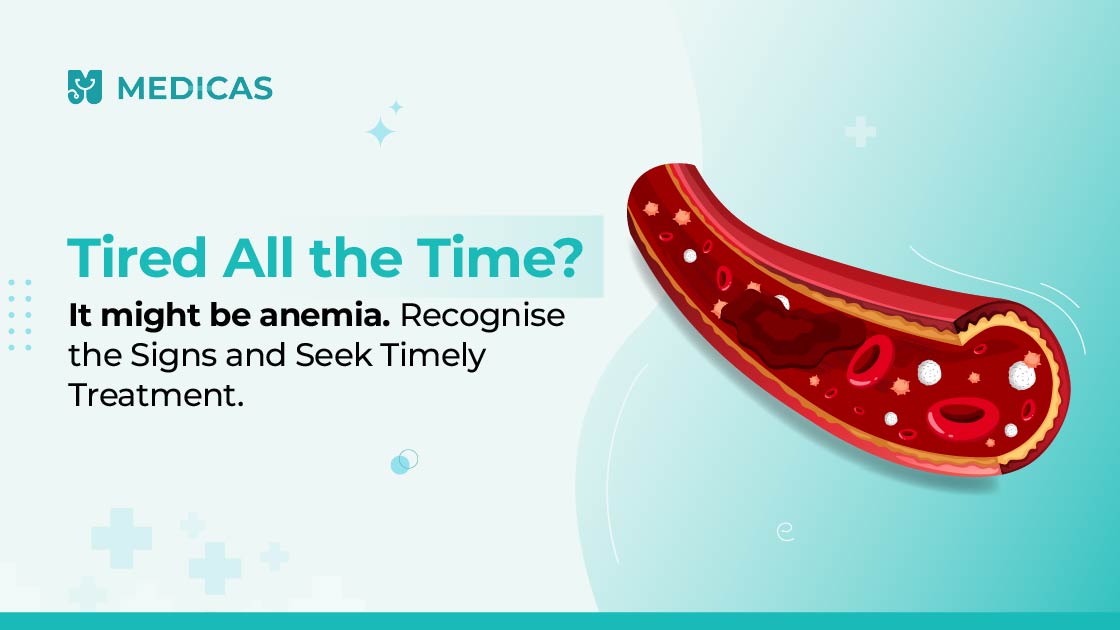Anemia is a condition that silently drains the vitality of millions, yet it’s often overlooked until symptoms become undeniable. In India, where dietary deficiencies and health disparities fuel its prevalence, understanding anemia is critical for taking charge of your well-being. This guide draws on my experience as a doctor to explain it, from signs and symptoms to treatment at home and beyond. Whether you’re navigating anemia in women, seeking how to treat anemia naturally, or exploring hemoglobin deficiency, I’ll provide practical tips and insights to help you manage this condition. With tools like booking a lab test or consulting the best doctor for anemia treatment online, you can address anemia with confidence.
What Is Anemia?
Anemia occurs when your body lacks enough healthy red blood cells or hemoglobin to carry oxygen effectively to tissues. This shortage leaves you feeling tired, weak, and sometimes breathless. In my practice, I often explain to patients that anemia isn’t just one condition but a group of disorders, with iron deficiency anemia being the most common. Understanding its impact and causes sets the foundation for recognizing symptoms of anemia and seeking timely anemia diagnosis.
Understanding How Anemia Affects the Body
When red blood cells or hemoglobin levels are low, organs and tissues don’t get enough oxygen, leading to fatigue and other symptoms of anemia. In India, where anemia in women is particularly prevalent due to poor nutrition and heavy menstrual bleeding, this can significantly affect daily life, from work to family responsibilities.
The Role of Hemoglobin in Your Health
Hemoglobin, a protein in red blood cells, binds oxygen in the lungs and delivers it throughout the body. A hemoglobin deficiency—common in anemia—disrupts this process, causing symptoms like weakness and dizziness. Regular anemia diagnosis through blood tests is crucial to monitor hemoglobin levels.
Common Types of Anemia
There are several types of anemia, each with unique causes:
- Iron deficiency anemia: Caused by low iron levels, often from diet or blood loss.
- Vitamin B12 or folate deficiency anemia: Linked to poor absorption or dietary lack.
- Sickle cell anemia: A genetic condition affecting red blood cell shape.
- Thalassemia: Common in India, caused by inherited hemoglobin deficiency. Knowing the type guides effective anemia treatment.
Symptoms You Shouldn’t Ignore
The signs and symptoms of anemia can creep up slowly, often mistaken for stress or overwork. Recognizing these early is key to preventing complications and starting anemia treatment promptly.
Fatigue and Weakness
Persistent fatigue is the hallmark of anemia. Patients often tell me they feel drained despite adequate rest. This exhaustion, caused by hemoglobin deficiency, can hinder daily tasks and signal the need for anemia diagnosis.
Pale Skin and Dizziness
Symptoms of anemia like pale skin, especially in the nails or inner eyelids, and dizziness when standing are common. In India, where anemia in women is widespread, these signs are often dismissed as normal but shouldn’t be ignored.
Shortness of Breath and Chest Pain
Feeling short of breath during light activity or experiencing chest pain can indicate severe anemia. These signs and symptoms of anemia require immediate attention, as they suggest your body is struggling to deliver oxygen.
What Causes Anemia?
Understanding the causes of anemia helps you address the root of the problem. From dietary deficiencies to chronic conditions, anemia has multiple triggers that I see in my practice daily.
Iron Deficiency and Nutritional Gaps
Iron deficiency anemia is the leading cause globally, especially in India, where vegetarian diets and limited access to iron-rich foods contribute. Low iron intake or poor absorption are common causes of anemia, particularly in women.
Chronic Diseases and Infections
Chronic conditions like kidney disease, diabetes, or infections like malaria can impair red blood cell production, leading to anemia. In India, widespread infections exacerbate hemoglobin deficiency in many patients.
Genetic Factors and Menstrual Loss
Inherited conditions like thalassemia, prevalent in certain Indian communities, are significant causes of anemia. Heavy menstrual bleeding also drives anemia in women, as blood loss depletes iron stores over time.
Diagnosing Anemia
Anemia diagnosis is straightforward but requires professional evaluation to pinpoint the type and cause. Early detection can prevent complications and guide effective anemia treatment.
Blood Tests and Medical Evaluation
Blood tests, such as a complete blood count (CBC), measure hemoglobin levels and red blood cell count. Additional tests like serum ferritin assess iron stores. These can be arranged through lab testing services for accurate anemia diagnosis.
Importance of Early Detection
Catching anemia early prevents worsening symptoms and complications like heart strain. Regular screenings, especially for anemia in women, are vital in India, where prevalence is high. Don’t wait for severe symptoms of anemia—act proactively.
Treatment Options for Anemia
Anemia treatment varies by type and severity, but the goal is always to restore hemoglobin levels and address underlying causes of anemia. I work with patients to create tailored plans that fit their lifestyle.
Iron Supplements and Medications
For iron deficiency anemia, iron supplements like ferrous sulfate are standard. Vitamin B12 injections or folate supplements treat deficiency anemias. Always follow a doctor’s guidance to avoid side effects, and consult the best doctor for anemia treatment online for personalized advice.
Dietary Recommendations
Foods to eat when you have anemia include iron-rich options like spinach, lentils, red meat, and fortified cereals. Vitamin C-rich foods, like oranges, enhance iron absorption. In India, incorporating jaggery and green leafy vegetables can support anemia treatment at home.
Lifestyle Changes and Home Remedies
How to treat anemia naturally involves lifestyle tweaks like regular meals, avoiding tea with iron-rich foods (it inhibits absorption), and staying hydrated. Explore additional home remedies for supportive care, but pair these with medical treatment.
When to See a Doctor for Anemia
Knowing when to see a doctor for anemia can prevent serious complications. If symptoms of anemia like fatigue, paleness, or shortness of breath persist, seek help immediately.
How Online Doctor Consultations Can Help
An online doctor consultation is a convenient way to discuss signs and symptoms of anemia, review test results, or start anemia treatment. I’ve seen patients benefit from the privacy and accessibility of virtual care, especially in rural India.
Managing Anemia in Women
Anemia in women is a pressing issue in India, driven by heavy periods, pregnancy, and dietary gaps. Regular screenings and iron-rich diets are critical, especially for pregnant women, where anemia can affect both mother and baby. Addressing hemoglobin deficiency early prevents long-term health risks.
Preventing Anemia: Tips for a Healthy Lifestyle
Preventing anemia involves proactive steps to maintain healthy hemoglobin levels. Simple habits can make a big difference in reducing your risk.
Regular Screenings and Balanced Diet
Routine blood tests catch anemia early, especially for high-risk groups like women. Eating foods to eat when you have anemia, like lentils, eggs, and leafy greens, supports STI prevention. Book a lab test for regular monitoring.
Exercise and Stress Management
Moderate exercise boosts circulation, while stress management supports overall health. In my practice, I encourage patients to combine these with dietary changes for effective anemia treatment at home.
Myths and Facts About Anemia
Misconceptions about anemia can delay care or create unnecessary worry. Here’s a table debunking common myths to help you understand anemia and its management.
| Myth | Fact |
| Anemia is just tiredness and not serious. | Anemia can lead to serious complications like heart problems if untreated. Recognizing signs and symptoms of anemia early is crucial. |
| Only women get anemia. | While anemia in women is common, men and children can also develop anemia due to various causes of anemia like diet or chronic disease. |
| Eating spinach alone cures iron deficiency anemia. | Spinach helps, but how to treat anemia naturally requires a balanced diet and often medical intervention for full recovery. |
| Anemia always has obvious symptoms. | Many cases of anemia are asymptomatic, especially early on, making anemia diagnosis through blood tests essential. |
| Supplements are enough for all types of anemia. | Anemia treatment depends on the type; iron deficiency anemia may need supplements, but others, like sickle cell, require different approaches. |
| Anemia only affects vegetarians. | While vegetarians face higher risk, causes of anemia like blood loss or chronic illness affect everyone, regardless of diet. |
| You can’t manage anemia at home. | Anemia treatment at home, like eating foods to eat when you have anemia and following medical advice, can support recovery. |
Clearing up these myths encourages proactive care, whether through online doctor consultations or in-person visits.
Conclusion
Anemia may feel like a daunting hurdle, but with the right knowledge and tools, it’s a condition you can manage effectively. By recognising signs and symptoms of anemia, understanding causes of anemia, and exploring how to treat anemia naturally or through medical care, you can reclaim your energy. Whether you’re addressing anemia in women, managing hemoglobin deficiency, or seeking the best doctor for anemia treatment online, resources like lab tests and booking an appointment make care accessible. In India, where anemia is widespread, early action and informed choices are your best allies for a healthier tomorrow.
Frequently Asked Questions
What are the early signs that I might have anemia? Early signs and symptoms of anemia include fatigue, pale skin, dizziness, and shortness of breath. Don’t ignore these—seek anemia diagnosis promptly. Can I book an online consultation for anemia symptoms? Yes, online doctor consultations allow you to discuss symptoms of anemia, review tests, and start anemia treatment conveniently. How effective is online treatment for managing iron deficiency anemia? Online treatment for iron deficiency anemia is highly effective, with doctors prescribing supplements and guiding dietary changes via virtual platforms. What foods should I eat to improve my hemoglobin levels naturally? Foods to eat when you have anemia include iron-rich options like spinach, lentils, jaggery, and red meat, paired with vitamin C sources like citrus fruits to boost absorption.
Disclaimer
Medical Advice: The information provided in this blog post is for educational purposes only and should not be considered as a substitute for professional medical advice, diagnosis, or treatment. Always consult with a qualified healthcare professional for personalized guidance regarding your specific medical condition.
Accuracy of Information: While we strive to provide accurate and up-to-date information, the field of medicine and viral fevers is constantly evolving. The content in this blog post may not reflect the most current research or medical guidelines. Therefore, it is advisable to cross-check any information provided with reliable sources or consult a healthcare professional.
Individual Variations: The symptoms, causes, treatment options, and preventive measures discussed in this blog post are general in nature and may not apply to everyone. It is important to remember that each individual’s situation is unique, and personalized medical advice should be sought when making healthcare decisions.
External Links: This blog post may contain links to external websites or resources for additional information. However, we do not endorse or have control over the content of these third-party websites. Accessing these links is done at your own risk, and we are not responsible for any consequences or damages that may arise from visiting these external sources.
Results May Vary: The effectiveness of treatment options or preventive measures mentioned in this blog post may vary from person to person. What works for one individual may not work the same way for another. It is essential to consult with a healthcare professional for personalized advice tailored to your specific needs.



